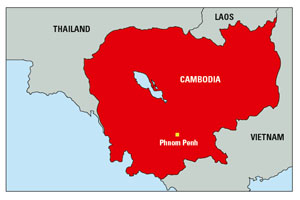Cambodia embraces intensive livestock production

In spite of many hurdles intensive livestock production in Cambodia starts to develop. Most of the initiatives and investments are driven by foreign companies who believe in a promising future in this country.
Cambodia, a Southeast Asian country with 15 million inhabitants, has begun to embrace intensive livestock production despite numerous obstacles. The industry heavily relies on the import of genetics, soybean meal, fish meal, additives, medicines and vaccines. A major constraint preventing producers from taking up intensive farming is the lack of access to electricity in rural areas.
The feed market in Cambodia is dominated by foreign investors and imports from neighbouring countries. An industry source foresees the feed industry in 2013 growing by around 10-15% , a slight decline from 2012 caused by unfavourable pork prices.
It is estimated that the total demand for feed is 100,000 tonnes/month. Around 55% is sold on the open market and 45% is produced and used internally by livestock producers. Although Cambodia has corn and cassava in abundance, the use of complete feed is becoming more common even among the many local small scale producers.
International feed companies
CP Cambodia is by far the largest supplier of complete feed, breeding stock, live animals, processed meat and ready-to-eat products. The company supplies 42,000 tonnes/month of feed for all livestock species, including the recently completed plant in Kandal province which has a capacity of 5,000 tonnes/month. Other players include Betagro which imports 3,500 tonnes from across the Thai border. It plans to invest US$500 million in a new mill with a capacity of 12,000 tonnes/month. In addition, China’s East Hope is constructing a new plant. An operation owned by Vietnam’s Green Feed in Kampong Cham supplies 6,000 tonnes; China’s New Hope Agribusiness (Cambodia), 2,000 tonnes; and Korea’s SCF (Cambodia) Co Ltd, 2,000 tonnes. Local players such as Cambodia’s Master Feed account for 4,000 tonnes/month; BVB 3,000 tonnes; M’s Pig, 900 tonnes.Feed is also imported from Vietnam by De Heus, Proconco, and Cargill. They captured a substantial market share in Cambodia due to more competitive pricing compared to local production or imported feed from Thailand.
Preference for pork
Traditionally Cambodia’s consumershave a preference for pork, which explains why the livestock market is dominated by pig production. Nevertheless the country relies on the import of breeding and finishing stock. Cambodia’s agriculture ministry estimates that total demand for pigs in the country is 3.25 million head. With a domestic production of 2.4 million, officials say, the need to import pigs will continue in the near future. Structural problems such as high interest rates, endemic disease, market volatility, and technological backwardness prevent the industry from meeting local demand over the near term. A substantial part of the live imports come from Thailand, but around one-third of all live animals imported from this country are re-exported to Vietnam.
Domestic production is primarily concentrated near the capital Phnom Penh. Major production centres are to be found in Kampong Speu and Kampong Cham, while the production in Siem Reap is emerging too.
The local market prefers 80 kg live animals. However, the market is willing to take 100 kg live weights if they are from animals with modern genetics, which offer leaner carcasses.Key players in pig parent stock production are CP Cambodia, 24,000; Monrethy, 3,000; BVB, 2,000; Betagro, 1,500; Kandal Dom Farm, 800. Also, India’s Organic Natural has 2,000 finishing pigs in Battambang and a private farm with 3,000 sows will soon be operating in Meanchey. It is estimated that the pig population will have expanded by at least 10% in 2012.
Demand for poultry meat and eggs
Like in most Asian countries consumers, once used to eat poultry meat, start to add this protein more often to their menu. Although the market still prefers coloured birds, there is an increasing demand for the modern white feathered bird. Broiler demand in Cambodia is around 800,000 – 1,000,000 birds per month. The market is highly volatile due to flows of surplus production from Thailand and Vietnam, either as day-old chicks, live birds or frozen meat.
Cambodia’s egg market is dominated by duck eggs, which are seen to be staple food. Layer ducks are most preferred as the ducks are fed free-range on leftovers from the rice harvest. However, chicken layer hens are becoming more popular due to better feed efficiency and the milder flavour of their eggs. At present, it is estimated that chicken eggs account for only 40% of the total egg market. The total chicken layer population is estimatedat 800,000 hens. Major players in this segment are CP Cambodia, Ngee Heng, Master Feed and SCF.
There are many opportunities to expand the livestock production in Cambodia, but there are various obstacle to take. By and large, poor logistics owing to underdeveloped ports, non-existent road infrastructures and utilities, together with the unfavourable scale of production remain major hurdles for livestock production in Cambodia. Market volatility is also a major problem because surplus pork, poultry, or eggs from neighbouring countries can flood into Cambodia at any time and depress prices.
**Source: World Poultry magazine 29. 1













